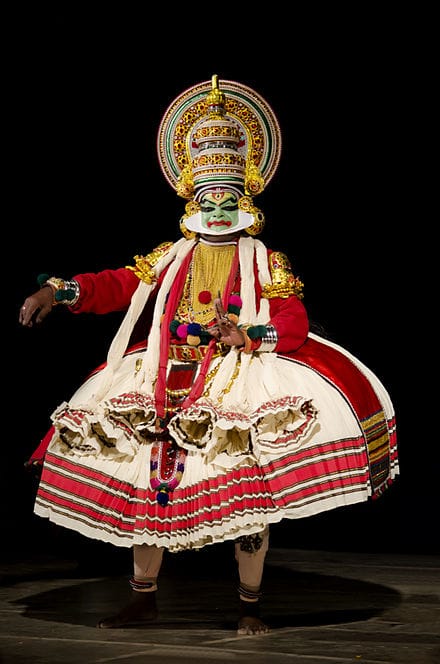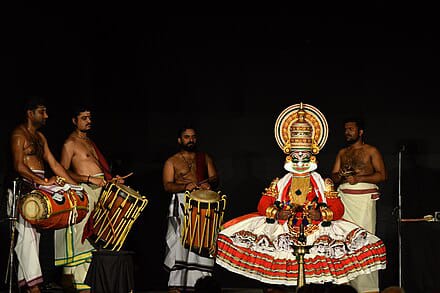In the vibrant tapestry of Indian performing arts, Kathakali stands as a beacon of tradition, embodying centuries of cultural heritage and artistic brilliance. Originating from the southern state of Kerala, Kathakali is more than just a dance form; it is a captivating synthesis of dance, music, drama, and spirituality. With its intricate movements, elaborate costumes, and profound narratives, Kathakali continues to enchant audiences worldwide, offering a glimpse into the rich cultural legacy of India.
The genesis of Kathakali can be traced back to the 17th century, flourishing under the patronage of the feudal rulers of Kerala. Drawing inspiration from ancient Sanskrit texts such as the Natya Shastra and the Ramayana, Kathakali evolved as a form of storytelling, blending elements of classical dance, martial arts, and ritualistic performances. Over the centuries, Kathakali underwent several transformations, adapting to changing socio-cultural landscapes while retaining its essence as a quintessentially Indian art form.
At the heart of Kathakali lies its distinctive repertoire of characters, each characterized by intricate facial expressions, hand gestures (mudras), and body movements. The performers, known as Kathakali artists, undergo rigorous training to master the nuances of their craft, honing their skills in abhinaya (expressive mime), nritya (pure dance), and natya (dramatic enactment). Central to Kathakali's aesthetic appeal is the concept of "rasa," or emotional flavor, which guides the artist in evoking a spectrum of sentiments, from love and devotion to valor and wrath.
One of the most visually striking aspects of Kathakali is its elaborate costumes and makeup, known as "aharya." The performers adorn themselves with vibrant attire, ornate jewelry, and towering headdresses, transforming into larger-than-life characters from Hindu mythology and epics. The hallmark of Kathakali makeup is its intricate facial painting, known as "chutti," which involves the application of natural pigments and rice paste to create exaggerated features and expressions. Each color and design holds symbolic significance, contributing to the character's portrayal and narrative context.
In Kathakali, music serves as a vital accompaniment, enriching the narrative and enhancing the emotional depth of the performance. The traditional musical ensemble, known as the "orchestra," comprises a combination of instruments such as the chenda (drum), maddalam (double-headed drum), chengila (cymbals), and elathalam (gong). The melodic framework is provided by vocalists who sing verses from ancient texts, while percussionists create rhythmic patterns that synchronize with the dancer's movements, creating a symphony of sound and motion.
Kathakali encompasses a diverse range of themes and narratives, drawing inspiration from Hindu mythology, epic sagas, and folklore. From the timeless tales of the Ramayana and Mahabharata to regional legends and historical chronicles, Kathakali brings to life a myriad of characters and stories, resonating with universal themes of love, courage, sacrifice, and redemption. Each performance unfolds like a visual poem, weaving together intricate gestures, expressive facial expressions, and evocative music to transport the audience into the realms of myth and imagination.
In recent decades, Kathakali has experienced a resurgence of interest and appreciation, both within India and on the global stage. Cultural institutions, academic programs, and performing arts festivals have played a pivotal role in preserving and promoting Kathakali, ensuring its legacy endures for future generations. Moreover, the allure of Kathakali has transcended geographical boundaries, captivating audiences in diverse cultural contexts and earning accolades for its aesthetic and artistic merit.
Despite its enduring popularity, Kathakali faces various challenges in the modern era, including dwindling patronage, evolving audience preferences, and the encroachment of digital media. However, these challenges also present opportunities for innovation and adaptation, as Kathakali artists explore new avenues for creative expression and outreach. Initiatives such as digital archives, educational workshops, and collaborative projects offer avenues for preserving Kathakali's heritage while engaging with contemporary audiences.
In a world marked by rapid change and uncertainty, Kathakali stands as a testament to the enduring power of art to transcend time and space. Through its timeless stories, mesmerizing performances, and profound spirituality, Kathakali continues to captivate hearts and minds, bridging the gap between tradition and modernity. As custodians of this ancient art form, it is incumbent upon us to cherish, nurture, and celebrate the legacy of Kathakali, ensuring its beauty and brilliance illuminate the cultural landscape for generations to come.






